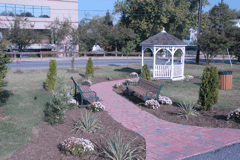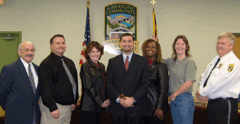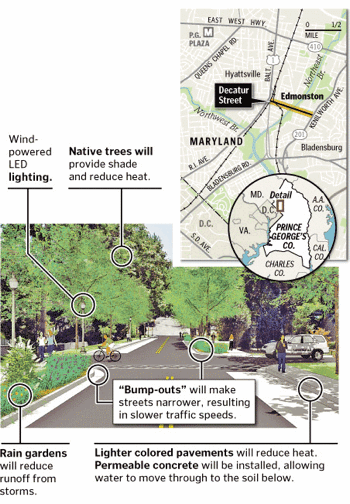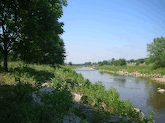From Mean Streets to Green Streets
Air Date: Week of August 7, 2009

Edmonston's town square. (Courtesy of the town of Edmonston)
On the banks of Maryland’s Anacostia River sits the small town of Edmonston. This town, which is a stone’s throw away from the nation’s capital, is trying to use economic stimulus money to create a sustainable street. This “green street” will have environmentally-friendly elements like an increased tree canopy and rain gardens that will filter run-off before polluted waters enter the river. Edmonston Mayor Adam Ortiz, takes host Jeff Young on a tour of his town and talks about his plan to revamp the main street.
Transcript
YOUNG: It’s Living on Earth, I’m Jeff Young.
When President Obama signed the economic recovery act six months ago he wanted to improve the environment as well as the economy. Billions of stimulus dollars poured into clean energy, mass transit and of course, the popular Cash for Clunkers program.
Most stimulus spending on transportation, however, is less environmentally friendly - old fashioned roads and highways.
But Edmonston, Maryland, a small working class town just outside of Washington, is putting recovery act money into an innovative project to green its mean streets.
Mayor Adam Ortiz says Edmonston’s main drag, Decatur Street, is noisy, hostile to pedestrians and prone to flash flooding.

Edmonston’s mayor Adam Ortiz (center) with city officials. (Courtesy of the town of Edmonston)
ORTIZ: Our town straddles the Anacostia River, which runs through Northeast and Southeast Washington D.C., flows into the Potomac and ultimately into the Chesapeake Bay. The Anacostia is kind of the forgotten river of our region and it’s the one that’s actually closest to the people. The Potomac is a beautiful river, but it’s primarily a rural river that comes out of West Virginia and Maryland. But the Anacostia flows through communities and is truly the nation’s urban river.
YOUNG: And sounds like from time to time Edmonston gets a little too much of the Anacostia.
ORTIZ: Well it’s funny you say that. We straddle the Anacostia, and for years we’ve struggled with terrible flooding. But this is kind of the interesting part, Jeff: our flooding does not come from the river. It comes from the storm water that flows off of parking lots and roads and highways and rooftops from this region trying to get to he Anacostia River. All of our flooding is completely manmade. So that’s part of the reason that we decided to try to be more environmentally responsible in our little corner of the world here.
YOUNG: Great. Let’s take it to the streets.
ORTIZ: Alright. Sounds good.
[SOUNDS OF DOOR OPENING]
ORTIZ: Edmonston was incorporated in 1924. The reason that we were incorporated was to build a bridge across the Anacostia River. Our slogan is that “we’re a bridging community” both literally in that bridge across the river, but also that we’re a working class town where people get their start in America. Our history is just rich with working folks getting a leg up and building a better life for their children here.

Edmonston’s plan for a green main street. (Courtesy of the town of Edmonston)
[SOUND OF CICADAS]
ORTIZ: It’s a hot and humid day here in metropolitan Washington with the sounds of cicadas around us.
[SOUND OF CICADAS]
ORTIZ: Okay, right now we’re at the corner of 52nd Avenue and Decatur Street. This is right on the green street. It’s gonna look very different six months from now.
YOUNG: What’s wrong with Decatur as it is now?
ORTIZ: Well, what’s wrong with it is it’s basically just a regular old street. And in watershed areas, particularly ours here in the Chesapeake Bay, a lot of the pollution comes from storm water mismanagement. That means that when the rain falls or rain comes down on hard surfaces it washes all the pollutants off of our roads and our streets and our parking lots into the concrete storm water system underground and into our rivers.
So the street now is just a very wide asphalt boulevard. And we’re gonna transform it into a new kind of main street that’s 100 percent environmentally responsible.
YOUNG: Well, how do you do that?
ORTIZ: Ok. Well, there’s a few things we’re gonna do. And we think about it from top to bottom. From the top of the tree canopy to the very, very bottom of the storm water system underground. And I’m gonna kind of take us through layer by layer.
Now at the top we need to improve our tree canopy here. We need to have bigger trees, native growth trees to reduce the heat island effect in a lot of urban areas and also increase the amount of birds and bats that can live in this area to be natural predators for mosquitoes and other insects that are problem and nuisances here.

The town of Edmonston straddles the Anacostia River. (Courtesy of the town of Edmonston)
YOUNG: You’re hopeful that you’re gonna have people moving on two wheels instead of four more often, yeah?
ORTIZ: Yeah, that’s exactly right. We’ll be building out bike paths. And actually those bike paths will be made with a special sort of brick that engineered to absorb water. So the storm water will actually fall through the bricks into our filtration system underneath the street. So it will be bike friendly. It will be environmentally friendly and it won’t look too bad either.
[TRAFFIC SOUNDS]
YOUNG: Now I can hear a lot of traffic roaring by there. I guess the goal is you want to slow ‘em down?
ORTIZ: Yeah, we want to slow ‘em down. We’re going to prohibit big trucks from being on the street. That’s not just a safety hazard but it does beat up the street quite a bit and also makes it a little less safe and, you know, of course the emissions coming from trucks are much greater and much worse than smaller vehicles for our residents here.
So we’re going to narrow the street, which means that we’ll have more room to increase the tree boxes, which are the green areas along the side. And this kind gets to the most important feature – those green areas are going to actually be natural rain garden filtration systems. They’ll be a number of layers of different types of sedimentation and rock and gravel on the bottom for the filter and on the top native plants and trees that will absorb pollutants as well. So, the water going up through the vegetation or down through the water table will be made clean again before it goes into the river if it does at all.

Edmonston's town square. (Courtesy of the town of Edmonston)
YOUNG: So you’re gonna slow down that run-off problem.
ORTIZ: Right, exactly. So it’s gonna keep areas in our town from getting overwhelmed by the effects of flash storms, which is certainly a problem these days. But its also just gonna keep rain water where it lands for the most part. That water will hit the ground and then drip into the ground like it did a hundred years ago before this pavement was here.
YOUNG: From the treetops right down to the subsoil you’re basically rethinking how the water moves, how the traffic moves, how the people move.
ORTIZ: Yeah, that’s exactly right. I mean everything is one hundred percent interconnected. You know, the way we build our streets affects the way that we behave, the way we drive, the way we walk, the way we interact. So every piece is significant. And you know, we’re doing our best to look at it as a whole. These are the veins, the arteries of our community. You know, we want to give them the best attention that we possibly can in the most responsible way.
YOUNG: And do we have an idea of what will be the effect on the Anacostia River? It sounds to me like in addition to doing good for Edmonston you’re gonna do some good downstream.
ORTIZ: We think so. The Anacostia River is not swimable, it’s not fishable, it’s certainly not drinkable. And when this street is complete we’re gonna cut off our contribution to that problem. And we hope it will make a small difference, but we hope over time that other towns and cities will do the same and we’ll have a bigger impact.
YOUNG: Hmm. So you want other towns and not just big towns to be able to do the same thing?
ORTIZ: Absolutely. You know, we hope that if our little working class town here can do this, anybody can do this. You know, we’re a pick-up truck town. Most of the homes have two bedrooms and one bathroom. But [laughs] that doesn’t mean that we can’t be environmentally responsible.
YOUNG: Adam Ortiz, mayor of Edmonston, thanks very much for the tour of your town.
ORTIZ: Thank you so much for your interest and steal our ideas everybody out there!
YOUNG: [Laughs] For details on how Edmonston is greening its streets– check out our website - loe.org
Links
Click here to learn more about the town of Edmonston’s green street project.
Living on Earth wants to hear from you!
Living on Earth
62 Calef Highway, Suite 212
Lee, NH 03861
Telephone: 617-287-4121
E-mail: comments@loe.org
Newsletter [Click here]
Donate to Living on Earth!
Living on Earth is an independent media program and relies entirely on contributions from listeners and institutions supporting public service. Please donate now to preserve an independent environmental voice.
NewsletterLiving on Earth offers a weekly delivery of the show's rundown to your mailbox. Sign up for our newsletter today!
 Sailors For The Sea: Be the change you want to sea.
Sailors For The Sea: Be the change you want to sea.
 The Grantham Foundation for the Protection of the Environment: Committed to protecting and improving the health of the global environment.
The Grantham Foundation for the Protection of the Environment: Committed to protecting and improving the health of the global environment.
 Contribute to Living on Earth and receive, as our gift to you, an archival print of one of Mark Seth Lender's extraordinary wildlife photographs. Follow the link to see Mark's current collection of photographs.
Contribute to Living on Earth and receive, as our gift to you, an archival print of one of Mark Seth Lender's extraordinary wildlife photographs. Follow the link to see Mark's current collection of photographs.
 Buy a signed copy of Mark Seth Lender's book Smeagull the Seagull & support Living on Earth
Buy a signed copy of Mark Seth Lender's book Smeagull the Seagull & support Living on Earth

